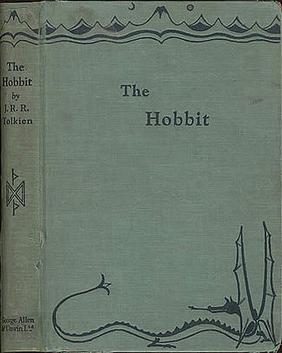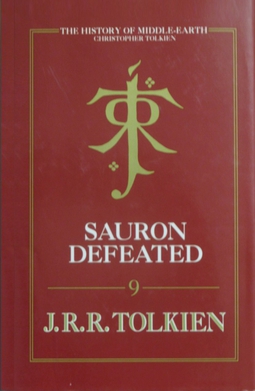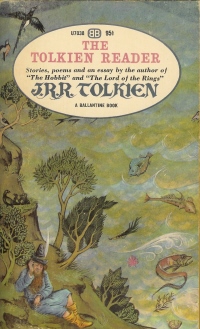
The Lord of the Rings is an epic high fantasy novel by the English author and scholar J. R. R. Tolkien. Set in Middle-earth, the story began as a sequel to Tolkien's 1937 children's book The Hobbit, but eventually developed into a much larger work. Written in stages between 1937 and 1949, The Lord of the Rings is one of the best-selling books ever written, with over 150 million copies sold.

The Hobbit, or There and Back Again is a children's fantasy novel by the English author J. R. R. Tolkien. It was published in 1937 to wide critical acclaim, being nominated for the Carnegie Medal and awarded a prize from the New York Herald Tribune for best juvenile fiction. The book is recognized as a classic in children's literature and is one of the best-selling books of all time, with over 100 million copies sold.

Bag End is the underground dwelling of the Hobbits Bilbo and Frodo Baggins in J. R. R. Tolkien's fantasy novels The Hobbit and The Lord of the Rings. From there, both Bilbo and Frodo set out on their adventures, and both return there, for a while. As such, Bag End represents the familiar, safe, comfortable place which is the antithesis of the dangerous places that they visit. It forms one end of the main story arcs in the novels, and since the Hobbits return there, it also forms an end point in the story circle in each case.

The History of Middle-earth is a 12-volume series of books published between 1983 and 1996 by George Allen & Unwin in the UK and by Houghton Mifflin in the US. They collect and analyse much of J. R. R. Tolkien's legendarium, compiled and edited by his son Christopher Tolkien. The series shows the development over time of Tolkien's conception of Middle-earth as a fictional place with its own peoples, languages, and history, from his earliest notions of "a mythology for England" through to the development of the stories that make up The Silmarillion and The Lord of the Rings. It is not a "history of Middle-earth" in the sense of being a chronicle of events in Middle-earth written from an in-universe perspective; it is instead an out-of-universe history of Tolkien's creative process. In 2000, the twelve volumes were republished in three limited edition omnibus volumes. Non-deluxe editions of the three volumes were published in 2002.

The Adventures of Tom Bombadil is a 1962 collection of poetry by J. R. R. Tolkien. The book contains 16 poems, two of which feature Tom Bombadil, a character encountered by Frodo Baggins in The Lord of the Rings. The rest of the poems are an assortment of bestiary verse and fairy tale rhyme. Three of the poems appear in The Lord of the Rings as well. The book is part of Tolkien's Middle-earth legendarium.

Pauline Diana Baynes was an English illustrator, author, and commercial artist. She contributed drawings and paintings to more than 200 books, mostly in the children's genre. She was the first illustrator of some of J. R. R. Tolkien's minor works, including Farmer Giles of Ham, Smith of Wootton Major, and The Adventures of Tom Bombadil. She became well-known for her cover illustrations for The Hobbit and The Lord of the Rings, and for her poster map with inset illustrations, A Map of Middle-earth. She illustrated all seven volumes of C. S. Lewis's Chronicles of Narnia, from the first book, The Lion, the Witch and the Wardrobe. Gaining a reputation as the "Narnia artist", she illustratred spinoffs like Brian Sibley's The Land of Narnia. In addition to work for other authors, including illustrating Roger Lancelyn Green's The Tales of Troy and Iona and Peter Opie's books of nursery rhymes, Baynes created some 600 illustrations for Grant Uden's A Dictionary of Chivalry, for which she won the Kate Greenaway Medal. Late in her life she began to write and illustrate her own books, with animal or Biblical themes.

Bilbo's Last Song is a poem by J. R. R. Tolkien, written as a pendant to his fantasy The Lord of the Rings. It was first published in a Dutch translation in 1973, subsequently appearing in English on posters in 1974 and as a picture-book in 1990. It was illustrated by Pauline Baynes, and set to music by Donald Swann and Stephen Oliver. The poem's copyright was owned by Tolkien's secretary, to whom he gave it in gratitude for her work for him.
The following outline is provided as an overview of and topical guide to the real-world history and notable fictional elements of J. R. R. Tolkien's fantasy universe. It covers materials created by Tolkien; the works on his unpublished manuscripts, by his son Christopher Tolkien; and films, games and other media created by other people.
The works of J. R. R. Tolkien have generated a body of research covering many aspects of his fantasy writings. These encompass The Lord of the Rings and The Silmarillion, along with his legendarium that remained unpublished until after his death, and his constructed languages, especially the Elvish languages Quenya and Sindarin. Scholars from different disciplines have examined the linguistic and literary origins of Middle-earth, and have explored many aspects of his writings from Christianity to feminism and race.
"Errantry" is a three-page poem by J.R.R. Tolkien, first published in The Oxford Magazine in 1933. It was included in revised and extended form in Tolkien's 1962 collection of short poems, The Adventures of Tom Bombadil. Donald Swann set the poem to music in his 1967 song cycle, The Road Goes Ever On.

The Tolkien Reader is an anthology of works by J. R. R. Tolkien. It includes a variety of short stories, poems, a play and some non-fiction. It compiles material previously published as three separate shorter books, together with one additional piece and introductory material. It was published in 1966 by Ballantine Books in the USA.

This is a list of all the published works of the English writer and philologist J. R. R. Tolkien. Tolkien's works were published before and after his death.

Middle-earth is the setting of much of the English writer J. R. R. Tolkien's fantasy. The term is equivalent to the Miðgarðr of Norse mythology and Middangeard in Old English works, including Beowulf. Middle-earth is the oecumene in Tolkien's imagined mythological past. Tolkien's most widely read works, The Hobbit and The Lord of the Rings, are set entirely in Middle-earth. "Middle-earth" has also become a short-hand term for Tolkien's legendarium, his large body of fantasy writings, and for the entirety of his fictional world.

Poems and Songs of Middle Earth is a studio album of spoken-word poetry by the English author J. R. R. Tolkien and art songs composed by the English musician Donald Swann. On the first half of the album, Tolkien recites seven poems from or related to his fantasy novel The Lord of the Rings (1954–55). The second half is a performance of Swann's song cycle The Road Goes Ever On, which sets selections from Tolkien's verse to music. The vocalist William Elvin sings The Road Goes Ever On to Swann's piano accompaniment. Caedmon Records issued the album on 18 October 1967 in the United States, and then on 28 March 1968 in the United Kingdom. Its release coincided with the publication of The Road Goes Ever On as a book of sheet music with commentary and illustration by Tolkien.

J. R. R. Tolkien's maps, depicting his fictional Middle-earth and other places in his legendarium, helped him with plot development, guided the reader through his often complex stories, and contributed to the impression of depth and worldbuilding in his writings.

Tolkien's artwork was a key element of his creativity from the time when he began to write fiction. A professional philologist, J. R. R. Tolkien prepared a wide variety of materials to support his fiction, including illustrations for his Middle-earth fantasy books, facsimile artefacts, more or less "picturesque" maps, calligraphy, and sketches and paintings from life. Some of his artworks combined several of these elements.
"The Shadow of the Past" is the second chapter of J. R. R. Tolkien's bestselling fantasy work, The Lord of the Rings, which was published in 1954–1955. Tolkien called it "the crucial chapter"; the Tolkien scholar Tom Shippey labelled it "the vital chapter". This is because it represents both the moment that Tolkien devised the central plot of the book, and the point in the story where the protagonist, Frodo Baggins, and the reader realise that there will be a quest to destroy the Ring. A sketch of it was among the first parts of the book to be written, early in 1938; later that year, it was one of three chapters of the book that he drafted. In 1944, he returned to the chapter, adding descriptions of Gollum, the Ring, and the hunt for Gollum.
In Tolkien's legendarium, ancestry provides a guide to character. The apparently genteel Hobbits of the Baggins family turn out to be worthy protagonists of The Hobbit and The Lord of the Rings. Bilbo Baggins is seen from his family tree to be both a Baggins and an adventurous Took. Similarly, Frodo Baggins has some relatively outlandish Brandybuck blood. Among the Elves of Middle-earth, as described in The Silmarillion, the highest are the peaceful Vanyar, whose ancestors conformed most closely to the divine will, migrating to Aman and seeing the light of the Two Trees of Valinor; the lowest are the mutable Teleri; and in between are the conflicted Noldor. Scholars have analysed the impact of ancestry on Elves such as the creative but headstrong Fëanor, who makes the Silmarils. Among Men, Aragorn, hero of The Lord of the Rings, is shown by his descent from Kings, Elves, and an immortal Maia to be of royal blood, destined to be the true King who will restore his people. Scholars have commented that in this way, Tolkien was presenting a view of character from Norse mythology, and an Anglo-Saxon view of kingship, though others have called his implied views racist.

J. R. R. Tolkien included many elements in his Middle-earth writings, especially The Lord of the Rings, other than narrative text. These include artwork, calligraphy, chronologies, family trees, heraldry, languages, maps, poetry, proverbs, scripts, glossaries, prologues, and annotations. Much of this material is collected in the many appendices. Scholars have stated that the use of these elements places Tolkien in the tradition of English antiquarianism.

Since the publication of J. R. R. Tolkien's The Hobbit in 1937, artists including Tolkien himself have sought to capture aspects of Middle-earth fantasy novels in paintings and drawings. He was followed in his lifetime by artists whose work he liked, such as Pauline Baynes, Mary Fairburn, Queen Margrethe II of Denmark, and Ted Nasmith, and by some whose work he rejected, such as Horus Engels for the German edition of The Hobbit. Tolkien had strong views on illustration of fantasy, especially in the case of his own works. His recorded opinions range from his rejection of the use of images in his 1936 essay On Fairy-Stories, to agreeing the case for decorative images for certain purposes, and his actual creation of images to accompany the text in The Hobbit and The Lord of the Rings. Commentators including Ruth Lacon and Pieter Collier have described his views on illustration as contradictory, and his requirements as being as fastidious as his editing of his novels.

















